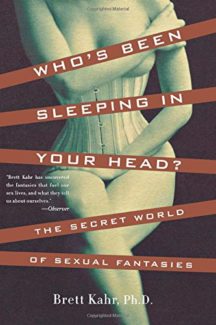 Our Heads Are Full
Our Heads Are Full
Author: Brett Kahr
During the early 2000s psychotherapist and psychoanalyst Brett Kahr undertook the largest study on the hidden realm of sexual fantasies, known as The British Sexual Fantasy Research Project. By the end of the enormous, multi-year study, in which Kahr sent in-depth questionnaires to many and even met with some, he received data from over 23,000 adults, men and women, ranging from ages 18 to 90. What resulted is this book: a five hundred page opus on everything lustful from group fantasies to celebrity fixations, from porn addiction to incest, from the ordinary and straight-forward to the extraordinary and complicated. Who’s Been Sleeping in Your Head runs the gauntlet from mundane to disturbing, trying to tease out what our secret sexual fantasies mean about us and where they come from.
It sounds intriguing. I ran into this book mostly by accident, perusing some online news article that made mention of the study as it discussed a particular woman, the daughter of holocaust survivors, who found that she only became aroused by thoughts of Nazis torturing her. Ensue psychological dilemma and the puzzling nature of our own quirky minds. What the article didn’t mention is that Kahr’s approach is strictly, worshipfully, Freudian. At least, it is when you finally traverse several hundred pages of raw data (fantasies) written by the participants and get to the bit where Kahr decides to break it down, or at least some of it.
 With such scintillating material and the ability to dive right into the darkest waters of the general public’s now revealed mind, you’d think that, scientific or not, Who’s Been Sleeping in Your Head, is destined to be a real page turner. Not so. First, the structure destroys itself with enervating repetitiveness and then the “every problem is a nail, and here is the Freudian hammer” finishes off the dying luster of our prurient curiosity.
With such scintillating material and the ability to dive right into the darkest waters of the general public’s now revealed mind, you’d think that, scientific or not, Who’s Been Sleeping in Your Head, is destined to be a real page turner. Not so. First, the structure destroys itself with enervating repetitiveness and then the “every problem is a nail, and here is the Freudian hammer” finishes off the dying luster of our prurient curiosity.
The book is structured into a four pronged approach. We start with Part One – The Secret Cinema in Our Minds. This section mostly breaks down the components of the experiment, how it was carried out, and why we should trust that its data is both unbiased and valid. Throw in some random early conclusions, which get repeated again and drawn out more later, and a horrifying dive into the “intra-marital affair” (i.e. almost everyone cheats on their spouse, at least in their hearts, because of their active fantasies) and you have a jumbled collection that starts with the facts and then goes off on a tangent.
Then, Bahr further confuses the narrative, talking about the beginning of his study and some of the ending, and thus starts Part Two – A Cornucopia of Fantasies. This section takes up most of the book and simply lists, back to back to back, many of the fantasies written in by those participating in the study. Many reviews and even Bahr himself in the beginning hint that this explosive material is where the money is at (so to speak). Not so. Despite readers’ lurid, prurient interests most of the fantasies reveal themselves as poorly written three to four sentence tidbits in the “See Jane Run” style. The more detailed fantasies are usually those that we find disturbing or comical. Soon, they all become repetitive (except the occasional grisly one), and the section wears on us as all this data is just dumped without explanation.
 Part Three – The Origins of Sexual Fantasy, finally follows the info-dump and it is here that Bahr boils down all sexual fantasies into a Freudian mélange. According to him and Freud, our sexual being arises in response to childhood trauma and our fantasies are a way of reliving and easing this trauma. See, these fantasies say, your trauma isn’t so bad now that you have added pleasure to it. Indeed, in some of the cases Bahr breaks down in this section, the correlation between a childhood incident and a fantasy are evident as coping mechanisms. Many of them, however, can’t be broken down so easily. Even Bahr will occasionally throw in, as though to refute readers in mid-thought, that he has pulled out all the stops and even for those patients and fancies that didn’t have an obvious childhood trauma correlation, there really is one buried deep. He takes two or three examples of difficult patients who finally ‘fess up to incidents and memories they have forgotten as the proof that even if we don’t see it, our fantasies are just traumatic events replaying themselves in disguise.
Part Three – The Origins of Sexual Fantasy, finally follows the info-dump and it is here that Bahr boils down all sexual fantasies into a Freudian mélange. According to him and Freud, our sexual being arises in response to childhood trauma and our fantasies are a way of reliving and easing this trauma. See, these fantasies say, your trauma isn’t so bad now that you have added pleasure to it. Indeed, in some of the cases Bahr breaks down in this section, the correlation between a childhood incident and a fantasy are evident as coping mechanisms. Many of them, however, can’t be broken down so easily. Even Bahr will occasionally throw in, as though to refute readers in mid-thought, that he has pulled out all the stops and even for those patients and fancies that didn’t have an obvious childhood trauma correlation, there really is one buried deep. He takes two or three examples of difficult patients who finally ‘fess up to incidents and memories they have forgotten as the proof that even if we don’t see it, our fantasies are just traumatic events replaying themselves in disguise.
I argue that common sense dictates that not everything is a nail awaiting a hammer. Some fantasies, sexual or otherwise, are no doubt coping mechanisms. Many of them, however, are not. And what of those that aren’t traumatic where the respondents effectively said their fantasy was simply being with their spouse or having a candle lit dinner or what not. Where is the trauma here? Is candle light secretly a symbol of some dark childhood fear of fire? Is wanting to be with your spouse in a sexual way actually a deep seated fear targeted at the longevity of your parents’ relationship? If so, we all need counseling in the worst kind of way.
 The final section, Part Four – Sexual Fantasies and the Outside World, attempts a conclusion. What it mostly contains is a rerun of Part One as Bahr takes on some random formulations: what does an intra-marital affair really mean to a relationship (again), who are some more patients whose sexual fantasies are obviously part of childhood trauma and what are their stories, etc. He does add a few extras including if you should/should not share your fantasies with your partner, how one can actively and non-judgmentally listen to fantasies and ask the underlying questions, and what the ten key dimensions of sexual fantasy (according to him) are based on the research and all we have read before. It’s a weak ending, just as the beginning was hurried and filled with tangents. Parts Three and Four are the obvious focus of the book, with Part Three being where the meat is, so to speak.
The final section, Part Four – Sexual Fantasies and the Outside World, attempts a conclusion. What it mostly contains is a rerun of Part One as Bahr takes on some random formulations: what does an intra-marital affair really mean to a relationship (again), who are some more patients whose sexual fantasies are obviously part of childhood trauma and what are their stories, etc. He does add a few extras including if you should/should not share your fantasies with your partner, how one can actively and non-judgmentally listen to fantasies and ask the underlying questions, and what the ten key dimensions of sexual fantasy (according to him) are based on the research and all we have read before. It’s a weak ending, just as the beginning was hurried and filled with tangents. Parts Three and Four are the obvious focus of the book, with Part Three being where the meat is, so to speak.
Who’s Been Sleeping in Your Head does not need five hundred pages; its beginning and ending parts could have been honed to one hard hitting chapter each. The data from the project could have been morphed into Bahr’s arguments and his dissection and examination of what the fantasy meant, with fantasies that went undiscussed placed in an appendix for the extra curious. The layout could have furthered the content of Bahr’s argument and at least kept readers engaged, if not invested in his Freudian reading of every situation. As it was, the book severely felt the lack of an editor and the final product, while voluminous, really said very little. A well written paragraph or two would have supported Bahr’s argument and depiction of his research better than five hundred pages that ultimately left us bored.
– Frances Carden
Follow my reviews on Twitter at: https://twitter.com/xombie_mistress
Follow my reviews on Facebook at: https://www.facebook.com/FrancesReviews/
[AMAZONPRODUCTS asin=”0465037674″]
- Book Vs Movie: The Shining - April 6, 2020
- Thankful For Great Cozy Mysteries - December 13, 2019
- Cozy Mysteries for a Perfect Fall - October 20, 2019


